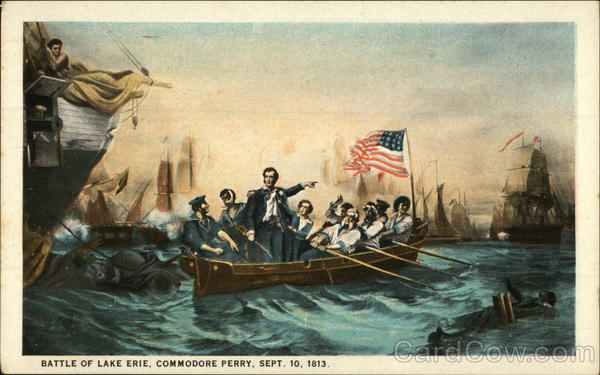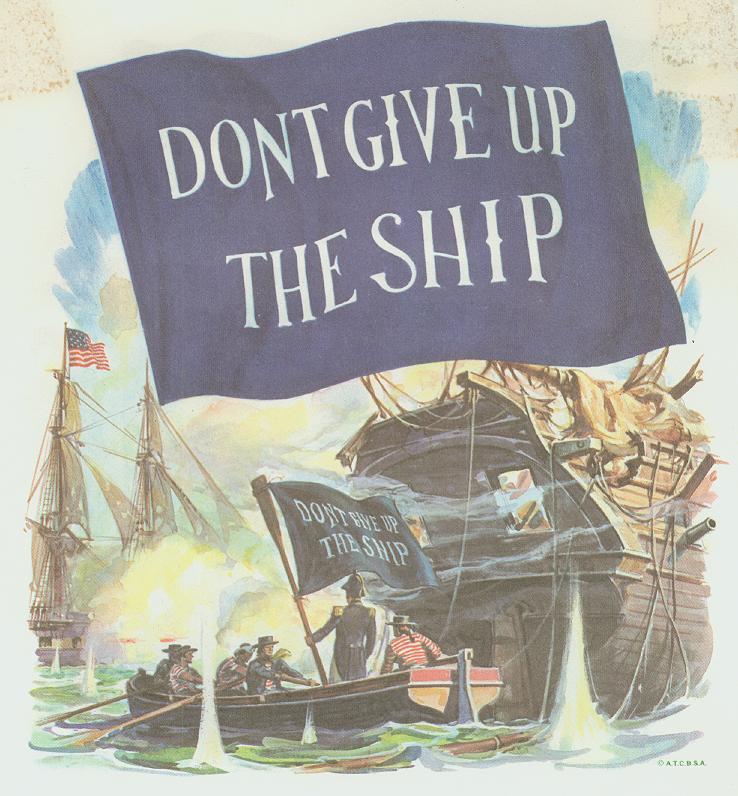
During the War of 1812, the United States had lost control of Lake Erie to the United Kingdom, this posed a large threat of UK invasion into Ohio, Pennsylvania, and New York. The United States also needed to regain control over Detroit; therefore the motives for the Battle of Lake Erie became clear.
Until September 10, 1813, Britain had control over Lake Erie giving them a large advantage in the great lakes region and putting United States at a disadvantage. Without naval superiority in the lake, United States lost battles of the coast line for the great lakes while British troops were easily able to gain reinforcements, supplies, and naval blockades to keep control over ports and Michigan, such as the battle of Detroit where the British successfully completed a landing from the lake to take Detroit, and gained a larger fleet by capturing the brig “Adams” and renaming the ship “Detroit” during repairs.
Commander Robert Heriot Barclay became the new commanding officer of the British Royal Navy’s fleet stationed in Lake Erie, and called off the blockade of the great lakes for lack of supplies. With the abandonment of city Detroit by Lieutenant Jesse Elliot, Oliver Hazard Perry was appointed head commander of United States Navy of Lake Erie, and took advantage of the dissipating blockade. Taking his new position at Put-in-Bay, Perry oversaw the production of two 20-gun brigs as well as collected many gunboats in preparation for the great battle yet to come. The two brigs in creation were called the “Niagara”, and the “Lawrence” (which Perry will chose as his flagship). The size of these ships were amazing. They both included 20-guns 2 x 12lb long-range cannons, and a wopping 18 x 32lb carronades and required a crew size of over 130 members each. Perry knew for sure that with the power of these ships, order could be restored to Lake Erie.
Barclay hearing that the US fleet was quickly increasing in size, returned to the shipyard only to find Perry’s brigs nearly completed and that had cleared the sand bar protecting the harbor. Realizing he was outgunned and out manned, Barclay retreated and waited for the completion of his fleets new brig the “Detroit” for his attempts at regaining control and tightened fist over Lake Erie. Now, with a the “big dogs” backing him up, Perry decided to “make a move”. Deciding to cut the supply lines of the British base in Amherstburg, this would force Barclay to start the naval Battle of Lake Erie to regain control a bit earlier and not be able to call for reinforcements, which was exactly what happened.
With the British fleet on its way, Perry’s ships departed Put-in-Bay harbor at 7 AM to move into position to attack the incoming British fleet. With the little available wind working against Perry, Barclay started the Battle at 11:45 AM with long range cannon fire while Perry’s ships were sitting ducks. Taking a full 30 minutes of long range cannon fire, Perry’s Lawrence was finally in position to return fire with the carronade broadside cannons. The Battle had finally became a full battle by 12:45 pm.
The orders had been given, Perry needed to move his largest two brigs (Lawrence and Niagara) into carronade range, but this came with some difficulties. Elliot (who was commanding captain of the Niagara) was ordered to engage Queen Charlotte, however, this wasn’t possible due to Lieutenant Elliot’s poor decision to slow. Since the Niagara fell behind, the Caledonia moved toward the British fleet to help the Lawrence. The Niagara’s path to the fight quickly became blocked by the US brig Caledonia. This accidental blocking of the Niagara from Caledonia created the opportunity for the British fleet to gain the upper hand and posed a huge threat to that of the US navy line. Now the British had the perfect opportunity to open full fire upon Perry’s flagship without real worry. The Lawrence took extremely heavy fire from both the Detroit, and Queen Charlotte and realized extremely heavy losses from receiving the Britishs’ fleet’s focus.
Both the British and US fleets launching devastating volleys of broadside cannon fire, but the Lawrence was soon overwhelmed and suffered 80% casualties. Barclay knew the Lawrence couldn’t last much longer; He had Perry on the ropes. Perry, also realizing his brig was out of options, had to act quickly. Aboard the Lawrence, four fifths of its crew were either dead or severely wounded, cannons were all shot from overloading, Perry had to think of his next move quickly. Expecting the US navy to retreat from the British taking the flagship down would prove their superiority, but this wasn’t the case. Perry knew the damage the Lawrence had caused to the enemy, he also knew they were also in trouble due to damaging the rudders. Instead of retreat, he needed to win, for US, for city Detroit, so he ordered Elliot to the US gunboats, and he ordered the transfer of his flag and himself to the undamaged brig (Niagara). Right before leaving the Lawrence, he was remembered to have said “Don’t Give Up the Ship” (which inspired the crew once again that this battle was not over).

Aboard the Niagara, Perry was not about to give up yet. He needed to surprise the British, catch them off guard. He knew they had rudder issues given to them from the Lawrence, and with rudder issues, the ability to retreat was also slipping from the British’s grasp. Perry gave the final orders. He had his crew aim the Niagara toward the the fray to finish what the Lawrence could not. Barclay staring down the Niagara’s bow, ordered his damaged vessels to turn and prepare for battle. Unfortunately, the British vessel rutters had been heavily damaged, and with the quick change in orders, caused Detroit and Queen Charlotte to collide. The Niagara was easily able to penetrate the British naval line due to the collision, and fired volleys upon volleys from the Niagara that devastated the helpless entangled ships as Perry circled the collision wreck. Elliot ordered his gunboats to move in and attack close to help the Niagara. With his two largest. most powerful ships in a collision, Barclay had no choice; the British fleet was completely helpless and was compelled to surrender.
United States had won the battle thanks to the brave and naval expertise of Perry. With many major setbacks, Perry and his navy still prevailed through a seemly impossible task. Perry, with his newly captured British vessels, wrote to General William Henry Harrison to report the battle “We have met the enemy and they are ours.”
|
|
Primary Sources
1. “Sea Power and its Relation to the War of 1812″ Alfred Thayer Mahan. 1905
2.”Oliver Hazard Perry and the Battle of Lake Erie” Altoff, Gerard T. 1999
3.”Lords of the Lake: The Naval War on Lake Ontario 1812-1814″ Malcomson, Robert. 1998
Secondary Sources
4. Military History “War of 1812: Battle of Lake Erie.”
5. Canada History (2012). “Battle of Lake Erie (canadahistory)”
6. War1812 Tripod.com. “Ware of 1812: Battle of Lake Erie”
For Further Reading
- Wikipedia. “Battle of Lake Erie. “


